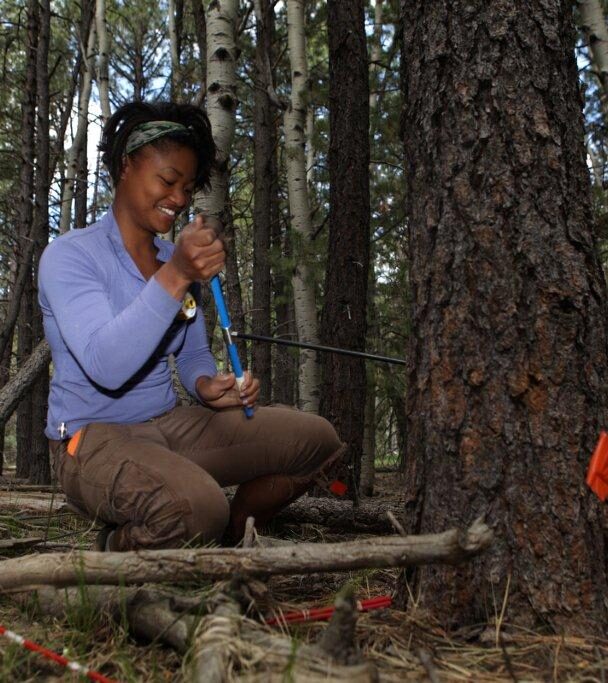Hart Prairie, with its lush grasslands, brilliant wildflowers and swaying aspen trees, is a popular spot this time of year, popular for hikers, birders, photographers and a number of different kinds of wildlife including herds of deer and elk. But this mountain meadow has been shrinking and drying.
“High alpine meadows similar to this are often encroached by pines,” said Ecological Restoration Institute student researcher Brian Moss. “It’s definitely a problem across the West.”
A problem, say researchers, because the thirsty pines may be crowding out other species and changing the way the meadow functions.
Joining Moss at Hart Prairie this summer are Northern Arizona University students Avianna Acid and Madison Daniels. They are climbing over downed trees, maneuvering around gnarly old growth pines and wrapping measuring tapes around the younger pines under the closed forest canopy. You’d never know it, but they are working in what used to be an open meadow.
With $1,650 in funding from the prestigious NAU Hooper Undergraduate Research Award, Moss is aging all the trees in the meadow to determine which ones were here historically.
“We are identifying the pre-settlement trees, the ones that are part of the natural environment and were here when the area was functioning with natural fire,” he said. “We also are determining the historic boundaries of the meadow.”
Meantime, The Nature Conservancy’s Hart Prairie Preserve program manager Neil Chapman has been studying the encroaching pine trees and wondering what this grassy alpine meadow would look and act like without them.
“We find a lot of the pines coming into this meadow are very young and very large trees, and soak up a whole lot of moisture that disrupts the natural balance for other plants including the rare Bebb willow,” said Chapman. “As we look at the restoration of the meadow and our willows, one of the factors is restoring the upslope forest conditions. All of the trees are about the same age and size as this tree.”
The tree he is comparing has about 70 tree rings. It’s about 70 years old and unusually large, about two feet in diameter. The amount of space between the rings tells a story. The moisture and openness of the meadow allowed these trees to grow big, fast. They were able to become established here because fire has been virtually eliminated from Hart Prairie since the late 1800s.
“We estimate between 50,000 and 80,000 gallons of water a day throughout the growing season are being absorbed by upslope pine trees that are encroaching into the meadow, reducing the surface flows and the underground flows for the willow drainages,” said Chapman.
Historic photos show the meadow to be at least twice the size of what it is today. Since the late 1800s, a forest of young, but large, pines has poured in like an avalanche.
“When trees move into a meadow, they significantly change the habitat that’s available to native wildlife,” said The Nature Conservancy forest ecologist Sarah Hurteau. “Turkeys, gophers, prairie dogs, elk, deer and pronghorn use this meadow. Pronghorn actually are a native species that are declining because of the lack of grasslands across the West. This is mostly due to fire suppression and the invasion of grasslands and savannahs with increased tree densities.”
As trees trickle into the open space, Moss says another important component of the forest is lost, something he calls the edge effect.
“The meadow edge is a really important area, too, because that’s where animals like to be so they can go into the woods to hide in a hurry if something comes while they are grazing on the grasses. The edge becomes less defined as trees move in.”
Chapman says findings from ERI researchers will help The Nature Conservancy determine what action to take to restore Hart Prairie and similar landscapes.
He is hoping the success of this meadow restoration project and adaptive management research will serve as an example for how to treat thousands of acres of overcrowded public land and demonstrate that sometimes trees, even large trees, need to be removed to restore ecosystems.
###
Link to The AZ Daily Sun Story

